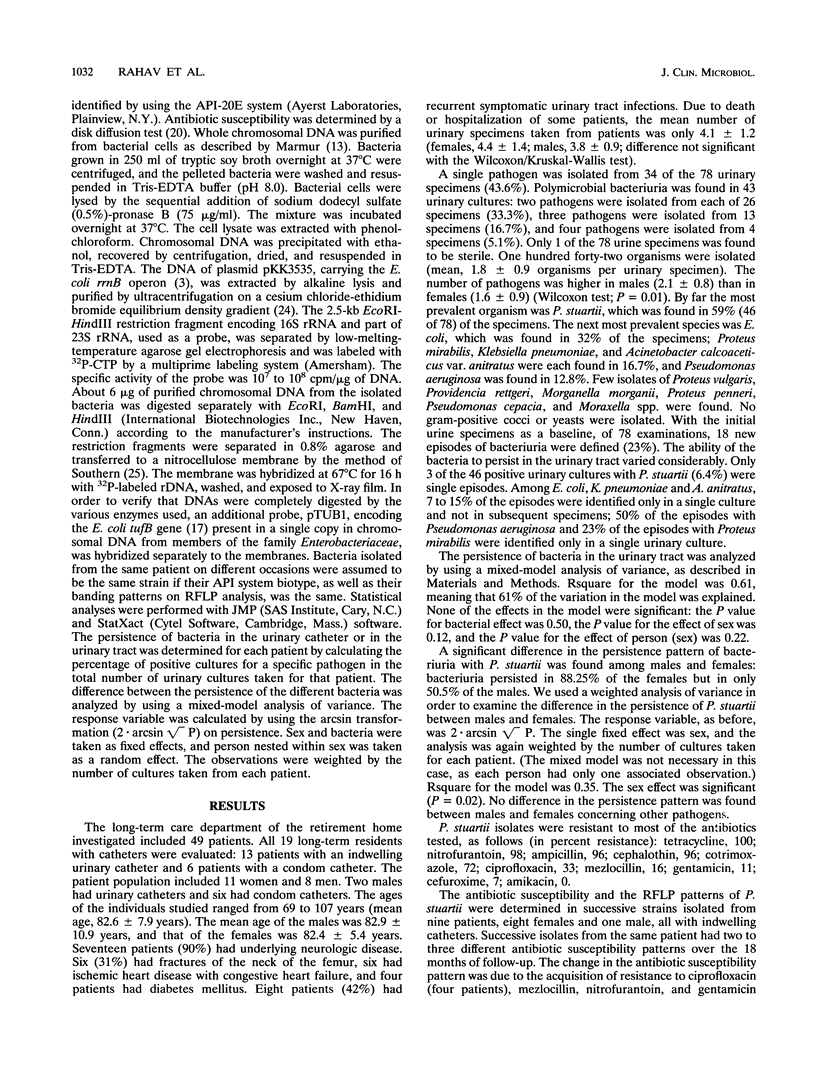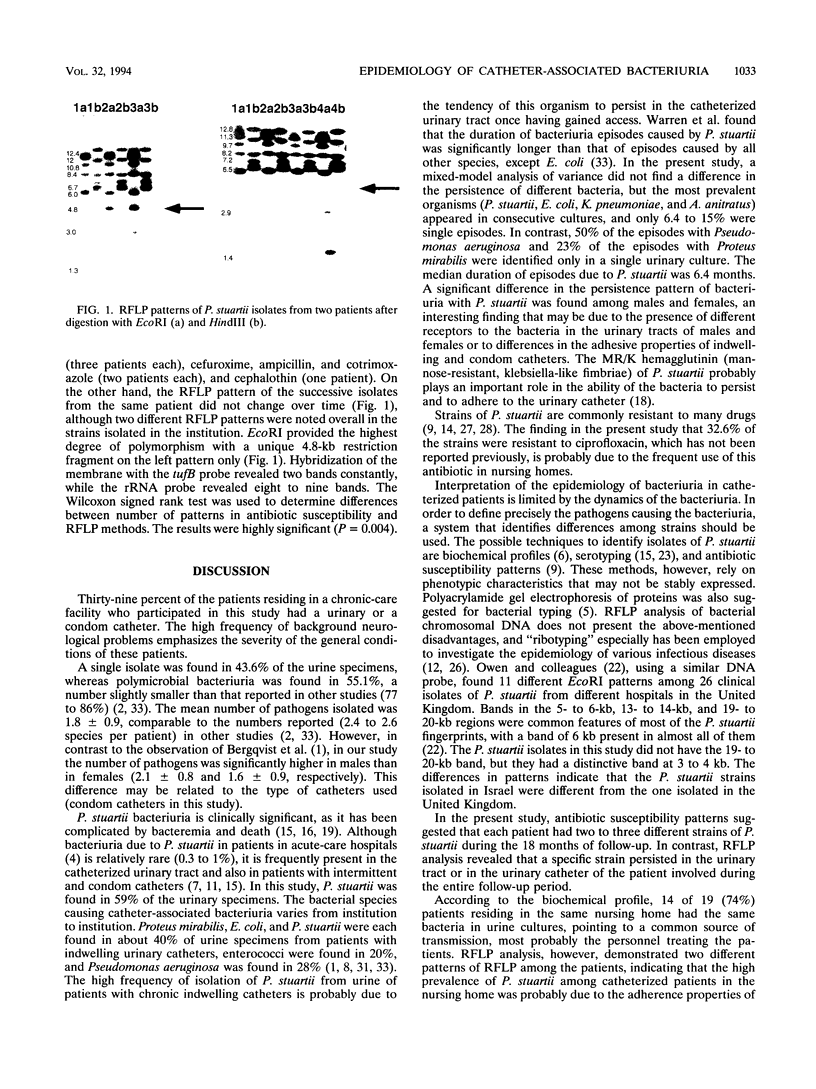Abstract
Urine samples from 19 nursing home patients with long-term urinary catheters were cultured every 3 months for 18 months. Providencia stuartii, present in 74% of the elderly and in 59% of urine specimens, was the most frequently isolated bacteria. The persistence of P. stuartii was significantly higher among females than among males. In order to study the epidemiology of bacteriuria in this nursing home, bacteria were characterized by biochemical tests, antibiotic susceptibility pattern, and restriction fragment length polymorphism (RFLP) analysis. The antibiotic susceptibility pattern indicated that each patient had two to three different strains of P. stuartii during the 18 months of follow-up. In contrast, the RFLP analysis revealed that a specific strain had persisted in the urinary tract of the patient during the entire follow-up period. According to the biochemical profile, 74% of the patients had the same bacteria in urine cultures, pointing to a common source of transmission. RFLP analysis, however, demonstrated different patterns of RFLP, suggesting concomitant multiple sources of infection.
Full text
PDF



Images in this article
Selected References
These references are in PubMed. This may not be the complete list of references from this article.
- Bergqvist D., Brönneståm R., Hedelin H., Ståhl A. Changes in the aerobic bacterial flora in the urinary tract of patients with long-term indwelling Foley catheters. Urol Res. 1980;8(1):43–47. doi: 10.1007/BF00261387. [DOI] [PubMed] [Google Scholar]
- Breitenbucher R. B. Bacterial changes in the urine samples of patients with long-term indwelling catheters. Arch Intern Med. 1984 Aug;144(8):1585–1588. [PubMed] [Google Scholar]
- Brosius J., Ullrich A., Raker M. A., Gray A., Dull T. J., Gutell R. R., Noller H. F. Construction and fine mapping of recombinant plasmids containing the rrnB ribosomal RNA operon of E. coli. Plasmid. 1981 Jul;6(1):112–118. doi: 10.1016/0147-619x(81)90058-5. [DOI] [PubMed] [Google Scholar]
- Costas M., Holmes B., Wood A. C. Numerical analysis of electrophoretic protein patterns of Providencia stuartii strains from urine, wound and other clinical sources. J Appl Bacteriol. 1990 May;68(5):505–518. doi: 10.1111/j.1365-2672.1990.tb02903.x. [DOI] [PubMed] [Google Scholar]
- Farmer J. J., 3rd, Davis B. R., Hickman-Brenner F. W., McWhorter A., Huntley-Carter G. P., Asbury M. A., Riddle C., Wathen-Grady H. G., Elias C., Fanning G. R. Biochemical identification of new species and biogroups of Enterobacteriaceae isolated from clinical specimens. J Clin Microbiol. 1985 Jan;21(1):46–76. doi: 10.1128/jcm.21.1.46-76.1985. [DOI] [PMC free article] [PubMed] [Google Scholar]
- Fierer J., Ekstrom M. An outbreak of Providencia stuartii urinary tract infections. Patients with condom catheters are a reservoir of the bacteria. JAMA. 1981 Apr 17;245(15):1553–1555. [PubMed] [Google Scholar]
- Garibaldi R. A., Brodine S., Matsumiya S. Infections among patients in nursing homes: policies, prevalence, problems. N Engl J Med. 1981 Sep 24;305(13):731–735. doi: 10.1056/NEJM198109243051304. [DOI] [PubMed] [Google Scholar]
- HOEPRICH P. D. Culture of the urine. J Lab Clin Med. 1960 Dec;56:899–907. [PubMed] [Google Scholar]
- Hawkey P. M. Providencia stuartii: a review of a multiply antibiotic-resistant bacterium. J Antimicrob Chemother. 1984 Mar;13(3):209–226. doi: 10.1093/jac/13.3.209. [DOI] [PubMed] [Google Scholar]
- Kocka F. E., Srinivasan S., Mowjood M., Kantor H. S. Nosocomial multiply resistant Providencia stuartii: a long-term outbreak with multiple biotypes and serotypes at one hospital. J Clin Microbiol. 1980 Feb;11(2):167–169. doi: 10.1128/jcm.11.2.167-169.1980. [DOI] [PMC free article] [PubMed] [Google Scholar]
- LiPuma J. J., Stull T. L., Dasen S. E., Pidcock K. A., Kaye D., Korzeniowski O. M. DNA polymorphisms among Escherichia coli isolated from bacteriuric women. J Infect Dis. 1989 Mar;159(3):526–532. doi: 10.1093/infdis/159.3.526. [DOI] [PubMed] [Google Scholar]
- McHale P. J., Keane C. T., Dougan G. Antibiotic resistance in Providencia stuartii isolated in hospitals. J Clin Microbiol. 1981 Jun;13(6):1099–1104. doi: 10.1128/jcm.13.6.1099-1104.1981. [DOI] [PMC free article] [PubMed] [Google Scholar]
- McHale P. J., Walker F., Scully B., English L., Keane C. T. Providencia stuartii infections: a review of 117 cases over an eight year period. J Hosp Infect. 1981 Jun;2(2):155–165. doi: 10.1016/0195-6701(81)90024-4. [DOI] [PubMed] [Google Scholar]
- Milstoc M., Steinberg P. Fatal septicemia due to Providence group bacilli. J Am Geriatr Soc. 1973 Apr;21(4):159–163. doi: 10.1111/j.1532-5415.1973.tb00868.x. [DOI] [PubMed] [Google Scholar]
- Miyajima A., Shibuya M., Kaziro Y. Construction and characterization of the two hybrid Co1E1 plasmids carrying Escherichia coli tufB gene. FEBS Lett. 1979 Jun 15;102(2):207–210. doi: 10.1016/0014-5793(79)80001-0. [DOI] [PubMed] [Google Scholar]
- Mobley H. L., Chippendale G. R., Tenney J. H., Mayrer A. R., Crisp L. J., Penner J. L., Warren J. W. MR/K hemagglutination of Providencia stuartii correlates with adherence to catheters and with persistence in catheter-associated bacteriuria. J Infect Dis. 1988 Feb;157(2):264–271. doi: 10.1093/infdis/157.2.264. [DOI] [PubMed] [Google Scholar]
- Muder R. R., Brennen C., Wagener M. M., Goetz A. M. Bacteremia in a long-term-care facility: a five-year prospective study of 163 consecutive episodes. Clin Infect Dis. 1992 Mar;14(3):647–654. doi: 10.1093/clinids/14.3.647. [DOI] [PubMed] [Google Scholar]
- Ouslander J. G., Kane R. L., Abrass I. B. Urinary incontinence in elderly nursing home patients. JAMA. 1982 Sep 10;248(10):1194–1198. [PubMed] [Google Scholar]
- Owen R. J., Beck A., Dayal P. A., Dawson C. Detection of genomic variation in Providencia stuartii clinical isolates by analysis of DNA restriction fragment length polymorphisms containing rRNA cistrons. J Clin Microbiol. 1988 Oct;26(10):2161–2166. doi: 10.1128/jcm.26.10.2161-2166.1988. [DOI] [PMC free article] [PubMed] [Google Scholar]
- Penner J. L., Hinton N. A., Duncan I. B., Hennessy J. N., Whiteley G. R. O serotyping of Providencia stuartii isolates collected from twelve hospitals. J Clin Microbiol. 1979 Jan;9(1):11–14. doi: 10.1128/jcm.9.1.11-14.1979. [DOI] [PMC free article] [PubMed] [Google Scholar]
- Southern E. M. Detection of specific sequences among DNA fragments separated by gel electrophoresis. J Mol Biol. 1975 Nov 5;98(3):503–517. doi: 10.1016/s0022-2836(75)80083-0. [DOI] [PubMed] [Google Scholar]
- Stull T. L., LiPuma J. J., Edlind T. D. A broad-spectrum probe for molecular epidemiology of bacteria: ribosomal RNA. J Infect Dis. 1988 Feb;157(2):280–286. doi: 10.1093/infdis/157.2.280. [DOI] [PubMed] [Google Scholar]
- Swiatlo E., Kocka F. E., Chittom A. L., Kantor H. S., Gac S., Waiters L. Survey of multiply resistant Providencia stuartii in a chronic care unit. J Hosp Infect. 1987 Mar;9(2):182–190. doi: 10.1016/0195-6701(87)90058-2. [DOI] [PubMed] [Google Scholar]
- Tenney J. H., Warren J. W. Bactericidal activity of norfloxacin and nine other urinary tract antibiotics against Gram-negative bacilli causing bacteriuria in chronically catheterized patients. J Antimicrob Chemother. 1983 Mar;11(3):287–290. doi: 10.1093/jac/11.3.287. [DOI] [PubMed] [Google Scholar]
- VOSTI K. L., GOLDBERG L. M., MONTO A. S., RANTZ L. A. HOST-PARASITE INTERACTION IN PATIENTS WITH INFECTIONS DUE TO ESCHERICHIA COLI. I. THE SEROGROUPING OF E. COLI FROM INTESTINAL AND EXTRAINTESTINAL SOURCES. J Clin Invest. 1964 Dec;43:2377–2385. doi: 10.1172/JCI105112. [DOI] [PMC free article] [PubMed] [Google Scholar]
- Warren J. W., Muncie H. L., Jr, Bergquist E. J., Hoopes J. M. Sequelae and management of urinary infection in the patient requiring chronic catheterization. J Urol. 1981 Jan;125(1):1–8. doi: 10.1016/s0022-5347(17)54874-0. [DOI] [PubMed] [Google Scholar]
- Warren J. W. Providencia stuartii: a common cause of antibiotic-resistant bacteriuria in patients with long-term indwelling catheters. Rev Infect Dis. 1986 Jan-Feb;8(1):61–67. doi: 10.1093/clinids/8.1.61. [DOI] [PubMed] [Google Scholar]
- Warren J. W., Tenney J. H., Hoopes J. M., Muncie H. L., Anthony W. C. A prospective microbiologic study of bacteriuria in patients with chronic indwelling urethral catheters. J Infect Dis. 1982 Dec;146(6):719–723. doi: 10.1093/infdis/146.6.719. [DOI] [PubMed] [Google Scholar]



